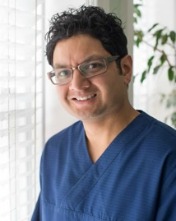Make your CEREC investment pay By Zac Fine. September 7, 2016.
Looking for some more valuable practitioner insight this week we talked to Dr Anesh Patel, co-owner of Cliftonville Dental in Northampton with his wife Dr Arti Shah.
Having worked with Anesh we knew he knew more than most about how to get payback quickly for the CEREC machine and we asked him to share what he’s learnt with you. Very kindly, he obliged:
“CEREC was on our radar for the last few years but we decided to take the plunge two years ago. The practice was going through a transition period at that time where it was becoming extremely busy and so we introduced more clinicians, extended our opening hours and offered more services. As part of this transition we decided to invest in more technology which included the CEREC system.
The investment is obviously sizeable so we initially sat down and did the maths to see if it would be viable and we came up with a six year plan to pay it off through savings made by using CEREC instead of a laboratory for our crown and onlay work.
The costs of the CEREC including the furnace and accessories was £85k. An annual servicing/maintenance contract is £2k/year which equates to £12k over six years, and interest from the loan we took out would be approximately £6k over this period. This gave a total cost of approximately £103k over six years.
The cost of using CEREC for each unit is £20 and the equivalent cost of using a laboratory is £90 so there is a saving of £70. We carry out approximately 25 units a month so £70 x 25 units is £1,750/month.
This saving would be in the region of £18.5k/year taking account of clinician holidays. By these calculations it would take between five and six years to pay off the CEREC. Naturally, this isn’t an exact science and there may be years when we carry out more or less CEREC cases so these figures may change, but this was our starting point. We are now two years down the road and ahead of schedule.
We have structured our appointment book to maximise our use of CEREC by introducing ’rock times’ for all the clinicians whereby the reception team can only book high value treatments such as CEREC and implants during these rock times. This ensures that when a patient accepts a high value treatment plan they don’t have a long wait for the treatment due to the diary being full of check-ups and low value treatments.
The benefit to patients is that compared to using a laboratory we can eliminate the need for impressions and temporaries, and the patient doesn’t need to attend for a second visit. When patients have failing large restorations we give them the option of replacing these with large composites or CEREC onlays, and after explaining the differences between them many opt for the onlays option. A big part of this is the effectiveness of communication with the patient, which shouldn’t be underestimated.
Patients who have the treatment are wowed by the technology and word tends to spread fast. The number of patients I’ve had who have attended for a check-up and said that their colleague/friend/family member attended recently and had CEREC done, and they would like to know more about it. As word spreads it does raise the profile of the practice. Even just by having it in the room it draws patients’ attention to it and opens up discussions.
My advice for anybody wanting to invest in CEREC would be to ensure it will be financially viable and that there is a plan of action to pay it off in x number of years. If the practice currently only carries out a handful of laboratory-based work a month then it isn’t ready for CEREC because it will take far too long to pay it off.
In addition, if the clinicians within a practice don’t have good rapport-building and communications skills, and cannot show to patients that they are genuinely interested in what is best for them, then that type of practice isn’t ready either.
Training in this area should be considered. You can be the best clinician in the world with the most amazing technology, but if you don’t have these skills you could end being one of those practices where a CEREC unit sits in the corner of the surgery collecting dust and accumulating debt.
Investing in CEREC was one of the best decisions we made. In my opinion, if the clinicians in a practice can communicate effectively and the appointment book is structured well, then CEREC can work well and take the practice to the next level.”
Anesh

“Investing in CEREC was one of the best decisions we made”
Anesh Patel, co-owner of Cliftonville Dental
